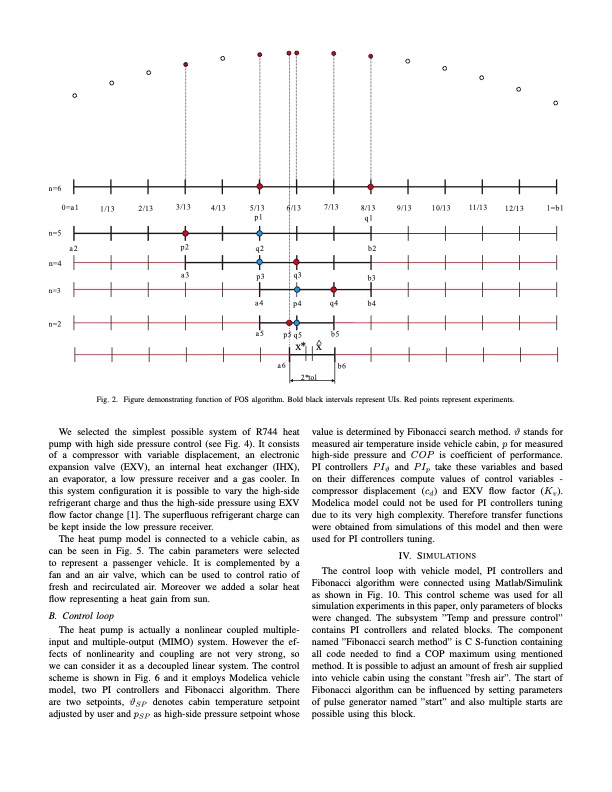
PDF Publication Title:
Text from PDF Page: 004
n=60=a1 1/13 2/13 3/13 4/13 5/13 6/13 7/13 8/13 9/13 10/13 11/13 12/13 1=b1 n=5 n=4 a2 p1 q1 p2 n=3 a3 q2 b2 p3 q3 b3 a4 p4 q4 b4 n=2 a5 p5q5 ^b5 a6 x* x b6 Fig. 2. Figure demonstrating function of FOS algorithm. Bold black intervals represent UIs. Red points represent experiments. 2 *to l We selected the simplest possible system of R744 heat pump with high side pressure control (see Fig. 4). It consists of a compressor with variable displacement, an electronic expansion valve (EXV), an internal heat exchanger (IHX), an evaporator, a low pressure receiver and a gas cooler. In this system configuration it is possible to vary the high-side refrigerant charge and thus the high-side pressure using EXV flow factor change [1]. The superfluous refrigerant charge can be kept inside the low pressure receiver. The heat pump model is connected to a vehicle cabin, as can be seen in Fig. 5. The cabin parameters were selected to represent a passenger vehicle. It is complemented by a fan and an air valve, which can be used to control ratio of fresh and recirculated air. Moreover we added a solar heat flow representing a heat gain from sun. B. Control loop The heat pump is actually a nonlinear coupled multiple- input and multiple-output (MIMO) system. However the ef- fects of nonlinearity and coupling are not very strong, so we can consider it as a decoupled linear system. The control scheme is shown in Fig. 6 and it employs Modelica vehicle model, two PI controllers and Fibonacci algorithm. There are two setpoints, θSP denotes cabin temperature setpoint adjusted by user and pSP as high-side pressure setpoint whose value is determined by Fibonacci search method. θ stands for measured air temperature inside vehicle cabin, p for measured high-side pressure and COP is coefficient of performance. PI controllers P Iθ and P Ip take these variables and based on their differences compute values of control variables - compressor displacement (cd ) and EXV flow factor (Kv ). Modelica model could not be used for PI controllers tuning due to its very high complexity. Therefore transfer functions were obtained from simulations of this model and then were used for PI controllers tuning. IV. SIMULATIONS The control loop with vehicle model, PI controllers and Fibonacci algorithm were connected using Matlab/Simulink as shown in Fig. 10. This control scheme was used for all simulation experiments in this paper, only parameters of blocks were changed. The subsystem ”Temp and pressure control” contains PI controllers and related blocks. The component named ”Fibonacci search method” is C S-function containing all code needed to find a COP maximum using mentioned method. It is possible to adjust an amount of fresh air supplied into vehicle cabin using the constant ”fresh air”. The start of Fibonacci algorithm can be influenced by setting parameters of pulse generator named ”start” and also multiple starts are possible using this block.PDF Image | high-side pressure of R744 automotive heat pump using Fibonacci search

PDF Search Title:
high-side pressure of R744 automotive heat pump using Fibonacci searchOriginal File Name Searched:
2017_ISIE_R744_Fibonacci.pdfDIY PDF Search: Google It | Yahoo | Bing
CO2 Organic Rankine Cycle Experimenter Platform The supercritical CO2 phase change system is both a heat pump and organic rankine cycle which can be used for those purposes and as a supercritical extractor for advanced subcritical and supercritical extraction technology. Uses include producing nanoparticles, precious metal CO2 extraction, lithium battery recycling, and other applications... More Info
Heat Pumps CO2 ORC Heat Pump System Platform More Info
| CONTACT TEL: 608-238-6001 Email: greg@infinityturbine.com | RSS | AMP |